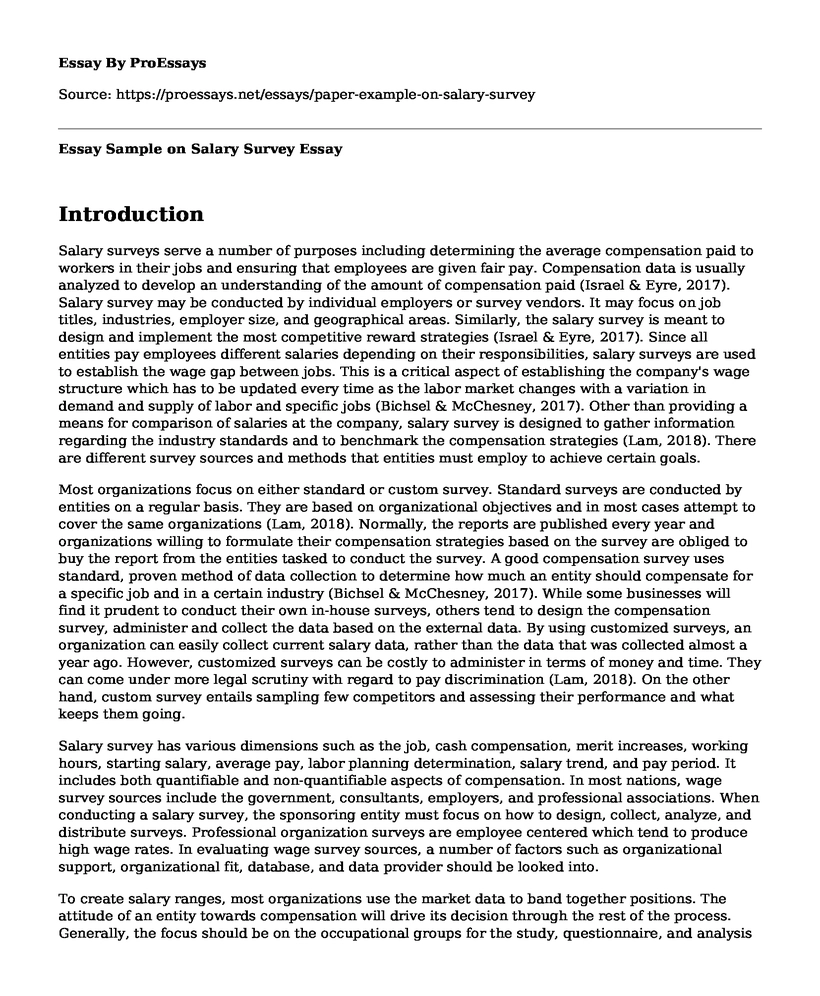Introduction
Salary surveys serve a number of purposes including determining the average compensation paid to workers in their jobs and ensuring that employees are given fair pay. Compensation data is usually analyzed to develop an understanding of the amount of compensation paid (Israel & Eyre, 2017). Salary survey may be conducted by individual employers or survey vendors. It may focus on job titles, industries, employer size, and geographical areas. Similarly, the salary survey is meant to design and implement the most competitive reward strategies (Israel & Eyre, 2017). Since all entities pay employees different salaries depending on their responsibilities, salary surveys are used to establish the wage gap between jobs. This is a critical aspect of establishing the company's wage structure which has to be updated every time as the labor market changes with a variation in demand and supply of labor and specific jobs (Bichsel & McChesney, 2017). Other than providing a means for comparison of salaries at the company, salary survey is designed to gather information regarding the industry standards and to benchmark the compensation strategies (Lam, 2018). There are different survey sources and methods that entities must employ to achieve certain goals.
Most organizations focus on either standard or custom survey. Standard surveys are conducted by entities on a regular basis. They are based on organizational objectives and in most cases attempt to cover the same organizations (Lam, 2018). Normally, the reports are published every year and organizations willing to formulate their compensation strategies based on the survey are obliged to buy the report from the entities tasked to conduct the survey. A good compensation survey uses standard, proven method of data collection to determine how much an entity should compensate for a specific job and in a certain industry (Bichsel & McChesney, 2017). While some businesses will find it prudent to conduct their own in-house surveys, others tend to design the compensation survey, administer and collect the data based on the external data. By using customized surveys, an organization can easily collect current salary data, rather than the data that was collected almost a year ago. However, customized surveys can be costly to administer in terms of money and time. They can come under more legal scrutiny with regard to pay discrimination (Lam, 2018). On the other hand, custom survey entails sampling few competitors and assessing their performance and what keeps them going.
Salary survey has various dimensions such as the job, cash compensation, merit increases, working hours, starting salary, average pay, labor planning determination, salary trend, and pay period. It includes both quantifiable and non-quantifiable aspects of compensation. In most nations, wage survey sources include the government, consultants, employers, and professional associations. When conducting a salary survey, the sponsoring entity must focus on how to design, collect, analyze, and distribute surveys. Professional organization surveys are employee centered which tend to produce high wage rates. In evaluating wage survey sources, a number of factors such as organizational support, organizational fit, database, and data provider should be looked into.
To create salary ranges, most organizations use the market data to band together positions. The attitude of an entity towards compensation will drive its decision through the rest of the process. Generally, the focus should be on the occupational groups for the study, questionnaire, and analysis of the comprehensive document which has to be delivered to employees. In the case of an independent survey, there is a need to provide participants with advanced copies of the completed survey.
References
Bichsel, J., & McChesney, J. (2017). Overview: 2017 Professionals in Higher Education Salary Report. College and University Professional Association for Human Resources.
Israel, R. H., & Eyre, J. R. (2017). The 2017 WArS/SAA Salary Survey: Initial Results and Analysis .Lam, J. (2018). The EMN Salary Survey: More Money for (Almost) Everybody. Emergency Medicine News, 40(6), 21.
Cite this page
Essay Sample on Salary Survey. (2022, Oct 19). Retrieved from https://proessays.net/essays/paper-example-on-salary-survey
If you are the original author of this essay and no longer wish to have it published on the ProEssays website, please click below to request its removal:
- Case Analysis Example: Life Tech versus Promega Corporation
- Cryptocurrencies and Blockchain Technologies: Bitcoin and Ripple (XRP)
- Why I Like the Apple Stock - Essay Sample
- Liquidity Analysis for Apple Paper Example
- How USA Does Business With Other Countries Essay Example
- Health Insurance Plans and Their Impact on the United States Essay Example
- Investing in Real Estate: Key Considerations for Maximum ROI - Essay Sample







